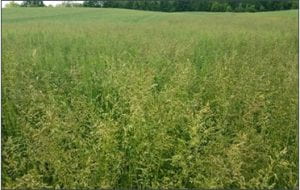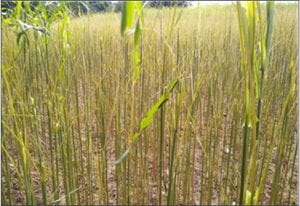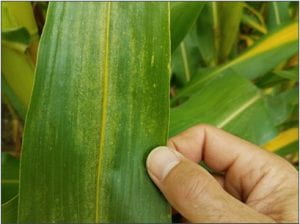Osprey Xtra Herbicide Approved for Winter Annual Grass Control in Wheat

Photo: M. Stanyard / CCE NWNY Team
Roughstalk bluegrass and cheat populations continue to increase across the region. These grasses emerge in the fall right along with the wheat. The NYSDEC recently approved a Special Local Needs (SLN) registration for Osprey Xtra (Osprey + Thiencarbazone) to replace Osprey for control/suppression of roughstalk bluegrass and cheat in winter wheat. Osprey Xtra can only be applied up to the jointing stage so it has to be sprayed early.
Purple Amaranth: Strange Pigweed Found in NWNY

Photo: M. Stanyard / CCE NWNY Team
Two separate people in different counties sent in pictures of a strange pigweed to identify. The plant has been identified as Purple Amaranth. Just what we need, another bad pigweed! Lucky for us, this one is not on the same level as it’s cousins, Palmer Amaranth and Waterhemp. It is not a new weed for NY but not very common and was first found in SE Michigan last year. It is easily distinguishable from other pigweeds by its unique notched leaf tip. Michigan State did find that it was resistant to Group 5 herbicides which includes atrazine. They have a nice resource paper on Purple Amaranth, https://www.canr.msu.edu/news/be-on-the-lookout-for-a-new-pigweed-species-purple-amaranth.
If you find Purple Amaranth, let us know so we can keep track of its distribution in the region.
Armyworms are Back for Round Two!

Common Armyworms are back and causing problems for growers in grass hay fields again. Reports of 6-7 per sq. foot are being reported in Wyoming County. It’s cousin, the Fall Armyworm can be a pest of later planted sorghum-sudan grass and corn. There are reports of damage throughout the state. It can be differentiated from the common armyworm by an inverted Y shape on the front of the head. Fall armyworms can cause severe defoliation in sorghum-sudan grass. Treatment should be based on the size of the armyworm, amount of defoliation and how close you are to harvest.
Spider Mite Injury in Corn?

Photo: M. Stanyard / CCE NWNY Team
There are some areas of NWNY, particularly up along Lake Ontario that have missed the rain showers and the spider mites have found the stressed corn. There are no established thresholds for mites in corn so how do you know if control is necessary? The first step is identifying that it is spider mites causing the injury. Plant leaves will look sand blasted along the length of the midrib (see picture) from mite feeding. Mites will be on the bottom side of the leaf. They are tough to see with the naked eye so you will need a magnifying lens to see them moving around. Here is a video of what you will see if mites are present.
Spider mites on corn leaf from Cornell Field Crops on Vimeo.
Purdue University states that control may be necessary if 15-20% of the leaf area is covered with mite colonies, moderate damage is noted and hot and dry weather persists. They also note the greatest benefits for control are between pre-tassel and the soft dough stage. Products for control of mites in corn include the miticide, Zeal (etoxizole), and insecticides, Dimethoate, Bifenthrin, Hero and Tundra Supreme.
Corn and Soybean Yield Contest Entries Due by August 30
 The deadline for the NYS Yield Contests is coming quickly! Despite the wacky weather we have had this year, there are some great looking corn and soybean fields across the region. I have heard predictions of 100 bushel beans and 300 bushel corn! This just might be that year. If you haven’t entered the contest before and you have some good-looking crops, give it a shot. Here is a link to the entry form and contest rules on the NY Corn and Soybean Growers Association webpage, https://nycornsoy.org/yield-contests/.
The deadline for the NYS Yield Contests is coming quickly! Despite the wacky weather we have had this year, there are some great looking corn and soybean fields across the region. I have heard predictions of 100 bushel beans and 300 bushel corn! This just might be that year. If you haven’t entered the contest before and you have some good-looking crops, give it a shot. Here is a link to the entry form and contest rules on the NY Corn and Soybean Growers Association webpage, https://nycornsoy.org/yield-contests/.


